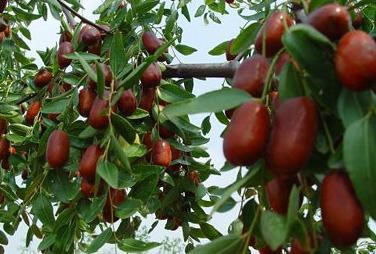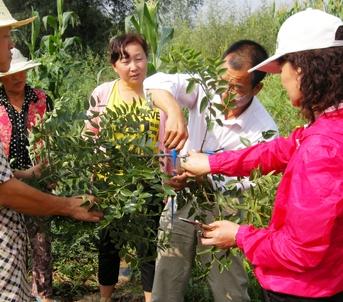Introduction to grafting techniques of jujube
Jujube can still be grafted from July to September, and because of the vigorous growth of branches and the full development of buds, the survival rate of grafting is relatively high.

I. skin grafting
Collect scions and select new jujube heads of 1-2-year-old good varieties suitable for local cultivation, remove all jujube hangers and leaves, cut out the first and secondary branches of jujube, and put them upright into plastic buckets filled with clear water for use.
The scion is prepared to take a robust primary or secondary branch from the plastic barrel and cut it into segments of 5'8'm, the upper cut is 0.5'm away from the bud hole, and the lower cut is no less than 5'm from the bud hole. The scion is cut off 1 × 2 in thickness and 2'3 cm in length on the back bud surface, and the corresponding face is cut off 0.5 cm at the lower end of the panicle with the same method, so that the scion is wedge-shaped with different lengths on both sides.
More than one-year-old jujube seedlings or wild jujube seedlings, scattered seedlings, root tiller seedlings and old nursery seedlings were selected as rootstocks. Cut at the base of the rootstock 3-10 cm from the ground, insert the scion between the cortex and cambium of the rootstock, expose 0.1 cm at the top, and apply a little ooze at the joint of the scion and the rootstock (be careful not to cover the bud hole). Use plastic straps to tie the rootstock to the scion, and then cover the rootstock and scion together with plastic film with a length of 8 meters, a width of 10 meters and a thickness of 0.006 mm. The top layer is close to the bud eye, and the lower layer seals the scion into the part of the rootstock. Finally, the binding part of the rootstock is fastened with plastic straps.
After grafting management 8-10 days after grafting, the scions sprouted one after another, and most of them could break the membrane. For those special plants with weak growth and difficulty in breaking the membrane, sharp needles can be used to cut the film at the bud so that the scion can grow normally after sprouting. After that, the jujube seedlings should be removed normally for 2 or 3 times, and the jujube seedlings should be protected by upright columns when they grow to 30 meters high, so as to prevent the wind from blowing off the jujube seedlings.

Second, the method of bud grafting with xylem
Collect scions and select annual branches with good varieties and strong growth, no diseases and insect pests, full bud eyes, lignin tissue with a diameter of 0.4 to 0.8 square meters, all of which are cut into small segments of 20 to 30 feet, wrapped in wet sand or wet sacks, and sprinkled with water to keep them moist and ready for use.
Sour jujube seedlings with strong growth, no diseases and insect pests and base diameter of more than 0.5 cm were selected as rootstocks. First cross-cut the selected part of the bud on the rootstock, reaching to the xylem, and then cut the T-shaped interface of 1.5 cm from top to bottom, or 0.5 cm above the full bud of the scion, up to 1-1.5 m deep in the xylem. Quickly cut the buds from the bottom to the top with a knife 1-1.5 m below the bud, the length is slightly shorter than the interface on the rootstock, and then stick the buds in the T-shaped interface of the rootstock. Align the cambium of the bud with the cambium of the rootstock (top and side) and tie it tightly with a plastic strip 0.5 cm wide.

Management after grafting 15-20 days after grafting to check whether the grafted seedlings survived (the method is that the petiole fell off as soon as the hand touched the bud, but not when the unsurvived hand touched), and the unsurvived ones could be repaired in time. In the following spring, cut the anvil 2-2.5 meters above the surviving scion and remove the plastic strip in order to promote the survival and germination of the scion. Regular spraying management should be conducted during the growing season to prevent and control diseases and insect pests.
The following editor will introduce the details.
Jujube is a tree species with relatively low survival rate of grafting. The author makes a slight improvement on the grafting measures to make the survival rate of split grafting reach more than 95%.
1. Select the scion. Before the jujube tree sprouted in early March, one-year-old strong branches were selected on the grafted variety tree, the secondary branches were cut off, and the middle and upper buds were cut into a section, leaving about 1 cm above the upper end bud of each section, so that there was enough Internode length at the lower end to cut.

two。 Scion treatment. Put the cut scion into a washed beverage bottle or other container, pour in 1%-2% sucrose water, soak it in a cool place for 5-7 days, rinse the scion repeatedly with clean water, store it in the freezer with plastic bags, soak it in sugar for 1-2 days before grafting, rinse thoroughly and moisturize.
3. Grafting. After the middle of April, the activity of the tree is active, and grafting can be carried out at this time. The scion is first wrapped with a film band 3 meters wide, leaving only the bud eye and the branches at the lower end of 2 to 3 meters. If it is bandaged after the scion is inserted, it is not only inefficient, but also easy to shift the scion in the interface and reduce the survival rate when bandaging the upper part of the scion. Then cut the lower end of the scion into a wedge. The xylem of jujube branches is relatively hard, and the knife used must be sharp to ensure that the section is smooth. After cutting, wrap it in a washed wet towel to prevent it from drying. When grafting and raising seedlings, cut off the rootstock 5 meters above the ground of the rootstock, and the height of jujube trees should select the branches with 1-3 years old, rising branches and active growth, and graft them in the lower part, leaving no other growing branches on the rootstock. The grafting operation is carried out according to the routine, the forming layer is aligned with meaning, and after the interface is tightly wrapped, the film belt is wrapped into a rope and forcefully tied several times at the cut of the rootstock, so as to reduce the gap between the rootstock and the scion.

4. Post-management. After grafting, the sprouts on the rootstock should be wiped out in time, and the binding material should be removed when the new stock is slightly longer than 20 cm. If the interface has not healed well, it can be re-wrapped and removed after one month. The scion grows vigorously after survival, and the branches and leaves are heavy, and it is easy to break at the interface in case of wind and rain. A strong stick should be tied up at the interface in time and released after autumn. Other aspects can be managed in accordance with the routine.
The above is the jujube grafting introduced to you by the editor.
Reduce the survival rate. Then cut the lower end of the scion into a wedge. The xylem of jujube branches is relatively hard, and the knife used must be sharp to ensure that the section is smooth. After cutting, wrap it in a washed wet towel to prevent it from drying. When grafting and raising seedlings, cut off the rootstock 5 meters above the ground of the rootstock, and the height of jujube trees should select the branches with 1-3 years old, rising branches and active growth, and graft them in the lower part, leaving no other growing branches on the rootstock. The grafting operation is carried out according to the routine, the forming layer is aligned with meaning, and after the interface is tightly wrapped, the film belt is wrapped into a rope and forcefully tied several times at the cut of the rootstock, so as to reduce the gap between the rootstock and the scion.

4. Post-management. After grafting, the sprouts on the rootstock should be wiped out in time, and the binding material should be removed when the new stock is slightly longer than 20 cm. If the interface has not healed well, it can be re-wrapped and removed after one month. The scion grows vigorously after survival, and the branches and leaves are heavy, and it is easy to break at the interface in case of wind and rain. A strong stick should be tied up at the interface in time and released after autumn. Other aspects can be managed in accordance with the routine.
The above is the jujube grafting introduced to you by the editor.
Related
- Wuhan Hospital Iron Tree Blooming Result Was Instantly Frightened by the Gardener Master
- Which variety of camellia is the most fragrant and best? Which one do you like best?
- What is the small blue coat, the breeding methods and matters needing attention of the succulent plant
- Dormancy time and maintenance management of succulent plants during dormancy
- Minas succulent how to raise, Minas succulent plant pictures
- What are the varieties of winter succulent plants
- How to raise succulent plants in twelve rolls? let's take a look at some experience of breeding twelve rolls.
- Attention should be paid to water control for succulent plants during dormant period (winter and summer)
- Watering experience of twelve rolls of succulent plants
- Techniques for fertilizing succulent plants. An article will let you know how to fertilize succulent plants.



